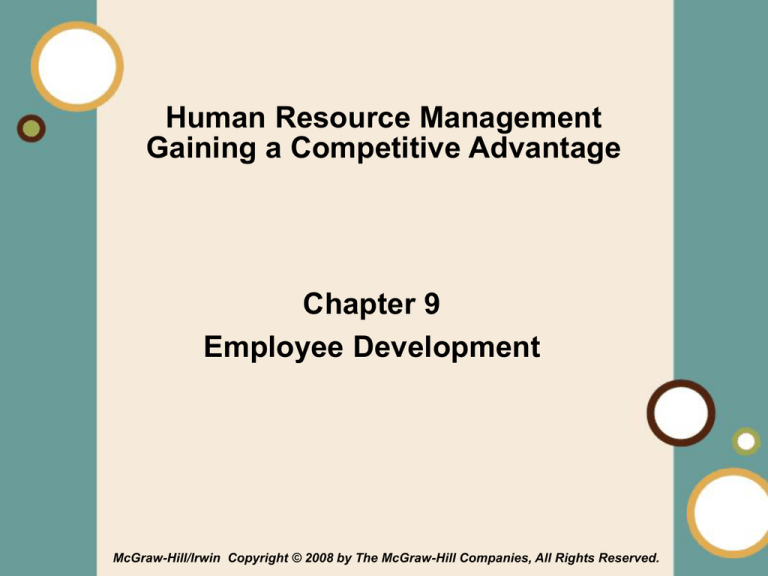
Human Resource Management
Gaining a Competitive Advantage
Chapter 9
Employee Development
McGraw-Hill/Irwin Copyright © 2008 by The McGraw-Hill Companies, All Rights Reserved.
1-1
Learning Objectives
After reading this chapter, you should
be able to:
• Explain how employee development contributes
to strategies related to employee retention,
developing intellectual capital, and business
growth.
• Discuss current trends in using formal
education for development.
• Relate how assessment of personality type,
work behaviors, and job performance can be
used for employee development.
• Explain how job experience can be used for skill
development.
9-2
Learning Objectives
After reading this chapter, you should
be able to:
• Develop successful mentoring programs.
• Describe how to train managers to coach
employees.
• Discuss the steps in the development planning
process.
• Explain the employees’ and company’s
responsibilities in planning development.
• Discuss what companies are doing for
management development issues including
succession planning, melting the glass ceiling,
and helping dysfunctional managers.
9-3
Comparison between Training
and Development
Training
Development
Focus
Current
Future
Use of work
experience
Low
High
Preparation for
Preparation for
current job
changes
Required
Voluntary
Goal
Participation
9-4
Development and Careers
• A protean career is based on selfdirection with the goal of psychological
success in one’s work.
• A psychological contract is the
expectations that employers and
employees have about each other.
• Psychological success is the feeling of
pride and accomplishment that comes
from achieving life goals.
9-5
Approaches to Employee
Development
• Formal education
• Assessment
–
–
–
–
Myers-Briggs test
Assessment center
Benchmarks
Performance
appraisals
– 360-Degree Feedback
Systems
• Job experiences
• Interpersonal
relationships
9-6
Assessment Centers
• At an assessment center, multiple
raters or evaluators evaluate
employees’ performance on a
number of exercises.
• Usually off-site.
• Types of exercises include:
–
–
–
–
Leaderless group discussion
Interviews
In-baskets
Role plays
9-7
Feedback Systems
• Upward feedback is a
performance appraisal
process for managers that
includes subordinates’
evaluations.
• 360-Degree Feedback is a
performance appraisal
system for managers that
includes evaluations from a
wide range of persons who
interact with the manager.
9-8
Employee Development
Experiences
Lateral Moves
Job
Rotation
Promotion
Vertical Assignments
Enlargement of
current job
experiences
Transfers
Downward Move
Temporary
assignments with
another organization
9-9
Job Experiences
• Job enlargement refers to adding challenges or
new responsibilities to an employee’s current jobs.
• Job rotation is the process of systematically
moving a single individual from one job to another
over the course of time.
• A transfer is a movement of an employee to a
different job assignment in a different area of the
company
• Promotions advances into positions with greater
challenge, more authority than the employee’s
previous job.
• A downward move occurs when an employee is
given a reduced level of responsibility and authority.
9-10
Temporary Assignments
• Externship refers to a
company allowing
employees to take a fulltime operational role at
another company.
• Temporary assignments
can include a sabbatical
which is a leave of
absence from the
company to renew or
develop skills.
9-11
Characteristics of Successful
Mentoring Programs
• Participation is voluntary
• Matching process if flexible
• Mentors are chosen on ability and
willingness
• Purpose is clearly understood
• Program length is specified
• Minimum level of contact is specified
• Contact among participants is
encouraged
• Program is evaluated
• Employee development is rewarded
9-12
Benefits of Mentoring
Relationships
• Career Support
– Coaching, protection, sponsorship, and
providing challenging assignments,
exposure, and visibility.
• Psychological support
– Serving as a friend and role model, providing
positive regard and acceptance, and creating
an outlet for a protégé to talk about anxieties
and fears.
• Group Mentoring Program
– A program pairing a successful senior
employee with a group of four to six less
experienced protégé.
9-13
Coaching
• A coach is a peer or manager
who works with an employee to:
– motivate him
– help him develop skills
– provide reinforcement and
feedback
• Three roles a coach can play
include:
– one-on-one
– help employee learn for himself
or herself
– may involve providing resources
such as mentors, courses, or job
experiences
9-14
Career Management Process
Action
planning
• Identify
opportunities
and needs to
improve
• Identify
what needs
are realistic to
develop
Reality Check
Goal Setting
• Identify steps
and timetable to
reach goal
• Identify goal
and method to
determine
goal progress
Selfassessment
9-15
Special Issues
• Melting the glass ceiling
– The glass ceiling is a barrier to advancement
to higher-level jobs in the company that
adversely affects women and minorities.
• Succession planning
– Identifying high-potential employees.
• Dysfunctional managers
– A number of studies have identified
managerial behavior that can cause an
otherwise competent manager to be a “toxic”
or inefficient manager.
9-16












